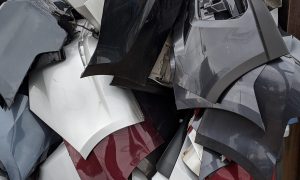
Recycling firm develops process to turn bumper fascias into new parts
By onAnnouncements
A major U.S. plastics recycler has announced a new bumper recycling process that involves turning fascias into pellets used to extrude or mold new parts.
In announcing its “first-of-its-kind” bumper recycling program this week, Ultra-Poly detailed how the process involves collecting damaged auto bumpers and turning them into raw material.
The material will be used to create a wheel well liner for GM heavy duty pickup trucks, Cronin said.
He added: “This recycled material has excellent mechanical and processing characteristics and is applicable for many different applications in automotive and is already commercial in applications such as dunnage and other material handling components.”
Ultra-Poly partnered with Autoneum North America Inc., a thermal and acoustic management vehicle solutions supplier, on the initiative.
“With the increasing challenge of OEMs to require more and more recycled content, this product delivers on that challenge,” said Dan Moler, Autoneum’s vice president of product development and engineering. “Everyone benefits – body shops, recyclers, automotive part manufacturers, OEMs, and most importantly, the environment.”
Ultra-Poly has been working for years on its initiative to turn discarded bumper fascias from auto body shops into raw material for manufacturing. It is also a member of the Plastics Industry Association, which announced in 2019 that its End-of-Life Vehicle Recycling Demonstration Project successfully proved “valuable” thermoplastic polyolefin (“TPO”) could be collected from bumper fascias.
Ultra-Poly said it was ultimately determined that the material could not be recovered for use back into new fascias, largely due to surface finish issues.
However, it said it saw an opportunity to use the material in non-appearance applications in both the automotive and industrial markets.
“This is a groundbreaking program that will help advance the automotive industry closer to achieving the standards of a circular economy,” Cronin said. “Sustainability is in the DNA of Ultra-Poly. Our commitment and expertise in improving the sustainability of the plastics industry is evident throughout our business model and we look forward to all that we can achieve with this innovative program.”
Ultra-Poly collects used bumper covers from auto body shops after they’ve been removed from vehicles and stripped of any usable parts. It said doing so offers two benefits for repairers. For one, it saves them money by removing bulky items from storage space without having to pay disposal fees. Another benefit, Ultra-Poly said, is that recycling the fascias ensures damaged products don’t return to the supply stream.
So far, Cronin said his organization has picked up more than 30,000 fascias from more than 200 body shops in Pennsylvania and northern New Jersey. Although it doesn’t normally offer payment for the fascias, Ultra-Poly said a number of shops have been happy to participate for other reasons.
“Quite a few shops have expressed that participating in this program gives them a strong sense of satisfaction that the material is being kept out of a landfill and going back into good productive use again,” he said.
According to the Plastics Industry Association, the initiative is also a win for the environment. It said in a 2021 case study that recycling bumper covers could spare about 1 million pounds of waste from heading to landfills.
